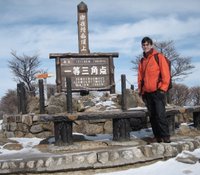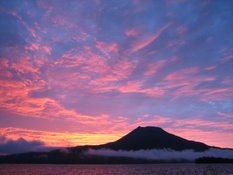
10 days since the last post. In that time I've finished instruction to my third year students and prepared for administering the final exams which were Friday and Saturday. But probably the real reason that I haven't written is that I've had the Fever. Olympic Fever! I'm always a sap for the Olympics so when they're on, I'm watching. Being in Japan during the Olympics has certainly been an experience: we're ahead of Torino by 8 hours. That means that live coverage begins at 11 pm here. I'm usually going to or in bed by that time, so I've sacrificed a little sleep for some vicarious glory with the athletes.
Of course most of the coverage focuses on the Japanese athletes and their sports. The first week it was mostly women's curling. That's okay with me, I got to learn a lot more about an interesting sport.
 Chess on ice they call it. I saw one highlight of the men's gold medal game between Canada and Finland. With one stone, Canada used angles and ricochet to knock out 4 of Finland's stones. It was so precise. Beautiful. Anywho, the Japanese women did not advance to the medal round but beat Great Britain who won the gold medal last time. On Japanese TV during the Olympics or other times (I don't know), they have a tradition of receiving faxed letters and drawings of encouragement for the athletes. I got so caught up with the action that I decided to draw my own picture and fax it in. Unfortunately, the curling team was eliminated before I could find a fax machine. But, you're in luck: I'm going to publish it here on my blog for the world to see! Beneath the curling stone is says "Nippon ganbatte!" Which means, "Japan! Fight!" It's a typical cheer or encouragement. Japan has only won one medal these games, but it's gold and probably the highest profile event: women's figure skating. Shizuko Arakawa has been all over the news and has lifted the spirits of people the neighborhood.
Chess on ice they call it. I saw one highlight of the men's gold medal game between Canada and Finland. With one stone, Canada used angles and ricochet to knock out 4 of Finland's stones. It was so precise. Beautiful. Anywho, the Japanese women did not advance to the medal round but beat Great Britain who won the gold medal last time. On Japanese TV during the Olympics or other times (I don't know), they have a tradition of receiving faxed letters and drawings of encouragement for the athletes. I got so caught up with the action that I decided to draw my own picture and fax it in. Unfortunately, the curling team was eliminated before I could find a fax machine. But, you're in luck: I'm going to publish it here on my blog for the world to see! Beneath the curling stone is says "Nippon ganbatte!" Which means, "Japan! Fight!" It's a typical cheer or encouragement. Japan has only won one medal these games, but it's gold and probably the highest profile event: women's figure skating. Shizuko Arakawa has been all over the news and has lifted the spirits of people the neighborhood.Last week I visited a classmate from college who's teaching at an eikaiwa (private English conversation school) in Mie prefecture. He has the unique experience of being the only native English speaker in town. It is quite a rural place. You can literally see a waterfall and a mountain from his balcony. So beautiful. After a busy week of test preparation, I was excited to have 2.5 days to stay with him.
I was in Kyoto for church on Sunday when I began my trip. The national train line, JR, has friendly bilingual signs, but I didn't see my transfer station of "Nagoya" on the fare map. Except for the Shinkansen, the bullet train. At 4900 yen for a 15 minute ride, its quite expensive. So I bought a limited express fare for 2400 yen and set off. But the only trains with "Nagoya" on their destination list were bullet trains. So I got waived through the turnstiles by the conductors even though the computers rejected my ticket. Something was up but I didn't know what. So I got on the bullet train and got an unreserved window seat. Score! Except it was in the smoking car. Oh well. The view of the Japanese Alps, which rise abruptly and majestically with snow-covered peaks, was inspiring to the point of inducing guilt. "I'm paying too little for this wonderful experience," I thought to myself. And I was right. When I attempted to exit in Nagoya, I was directed by the conductor to the "fare adjustment" counter. I had to fork over another 2500 yen. Oh well, it was worth it.
The train to Komono, where Nate lives, approaches the Suzuka Mountains. The Rokko Mountains are the backdrop to where I live, but they don't rise 1000 meters over a flat plain. So this was very exciting. Here's a picture of my view from the train.
 Nate lives across the street from the train station and came out to greet me. Talk about a sweet location. He came to visit me for Thanksgiving last November and I was embarrassed at the size of my apartment because it actually is quite big compared to most Japanese living spaces. Nate's apartment is quite small by comparison, although I have no pictures to show for it. It was made even smaller by Nate's PhD work (Piled high & Deep) in every room. After catching up on years and months gone by since college and our last visit in Japan, we set off for dinner.
Nate lives across the street from the train station and came out to greet me. Talk about a sweet location. He came to visit me for Thanksgiving last November and I was embarrassed at the size of my apartment because it actually is quite big compared to most Japanese living spaces. Nate's apartment is quite small by comparison, although I have no pictures to show for it. It was made even smaller by Nate's PhD work (Piled high & Deep) in every room. After catching up on years and months gone by since college and our last visit in Japan, we set off for dinner.Nate has been here for about a year and a half, so he has developed a nice network of friends and eating establishments that he frequents. Being that most classes at eikaiwa are in the evenings, Nate doesn't cook for himself very often, so he goes to the restaurants of his students. He gave me a choice of his "frequent five". I chose pasta. So far in Japan, I have avoided pasta restaurants for two reasons: 1) I can eat a lot of pasta back in the USA whereas the kind of Japanese food served here is hard to find in good quality in the USA (just ask Gena and Craig about Kabuki in Pasadena); 2) I imagined pasta in Japan to be undercooked noodles with ketchup sauce and therefore not appetizing. Well, I was shamefully wrong in this case. I ordered a simple spaghetti set which included salad and tiramisu dessert. It was better than Olive Garden, giving it an above-average rating. The tiramisu even had real whip cream, something that few American restaurants can top without a hefty bill. So the after dinner buzz was going. What better way to top it off than with a trip to the onsen: Japanese bath?
It was very relaxing to soak in hot spring water and clean out the pores. They had a big screen TV with Olympic cross-country skiing on. What a great way to end the day. I was so relaxed that I slept in until 10 the next morning. Monday, Nate and I did personal errands.
 It rained all day, so outdoor recreation was out. Nevertheless, we visited the local temple (Buddhist) and shrine (Shinto). I finally learned the difference between the two. Though I was reasonably confused because often the two are right next to each other. We walked through the cemetery as the sober sky showered a cold, drizzly rain upon our umbrellas. People's final resting places are often on hillsides because of the scarcity of flat land that is reserved for rice production.
It rained all day, so outdoor recreation was out. Nevertheless, we visited the local temple (Buddhist) and shrine (Shinto). I finally learned the difference between the two. Though I was reasonably confused because often the two are right next to each other. We walked through the cemetery as the sober sky showered a cold, drizzly rain upon our umbrellas. People's final resting places are often on hillsides because of the scarcity of flat land that is reserved for rice production.Tuesday morning, Nate left for Yokkaichi to teach a class. He dropped me off at the gondola that would take me up the mountain (yama). A school group arrived just before me. I could tell they were going to ski at the top because everyone was dressed in the same jump suit, hat and goggles.
 I went up a gondola with a ski school group and passed through thermoclines of fog which made for beautiful photographs. The summit of the mountain was covered in snow but quite warm and sunny. I hiked through the snow to the 1212m top (3972 feet). They say that you can see Mount Fuji and Lake Biwa from the summit, but there was a cloud cover that obscured my view. I was able to see an interesting shrine atop another peak nearby.
I went up a gondola with a ski school group and passed through thermoclines of fog which made for beautiful photographs. The summit of the mountain was covered in snow but quite warm and sunny. I hiked through the snow to the 1212m top (3972 feet). They say that you can see Mount Fuji and Lake Biwa from the summit, but there was a cloud cover that obscured my view. I was able to see an interesting shrine atop another peak nearby. After my trip to the summit it was time to come down. I had to begin my 5 hour journey home. It was easy to get lost in time with the wonderland feel of Mount Gozaisho, so I missed the most direct train back to Osaka. The second train had a few more connections and went a bit slower, but it made me a more hardened train riding veteran. I am becoming more of a train lover the longer I am here! Thanks for reading this far. I will try to write shorter and more frequent entries in the future.
After my trip to the summit it was time to come down. I had to begin my 5 hour journey home. It was easy to get lost in time with the wonderland feel of Mount Gozaisho, so I missed the most direct train back to Osaka. The second train had a few more connections and went a bit slower, but it made me a more hardened train riding veteran. I am becoming more of a train lover the longer I am here! Thanks for reading this far. I will try to write shorter and more frequent entries in the future.





No comments:
Post a Comment